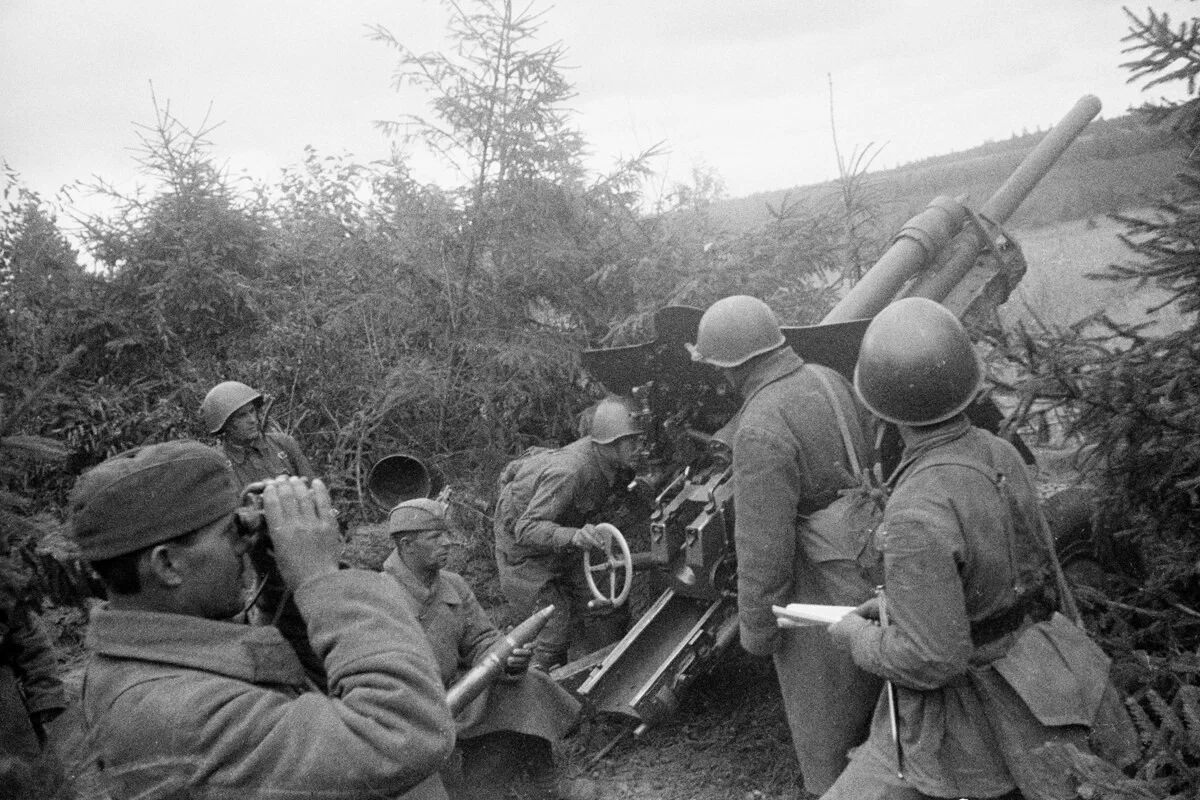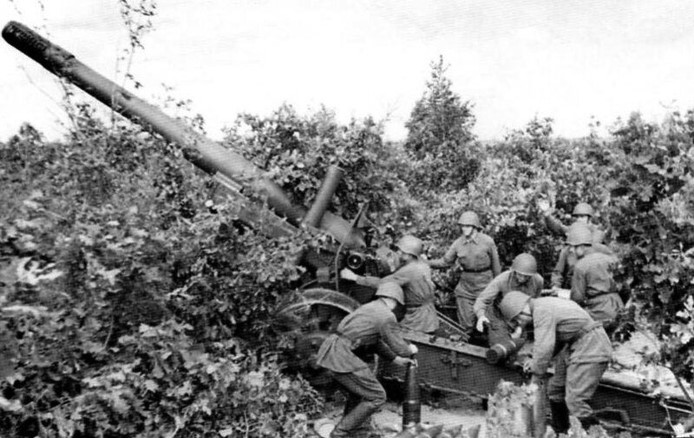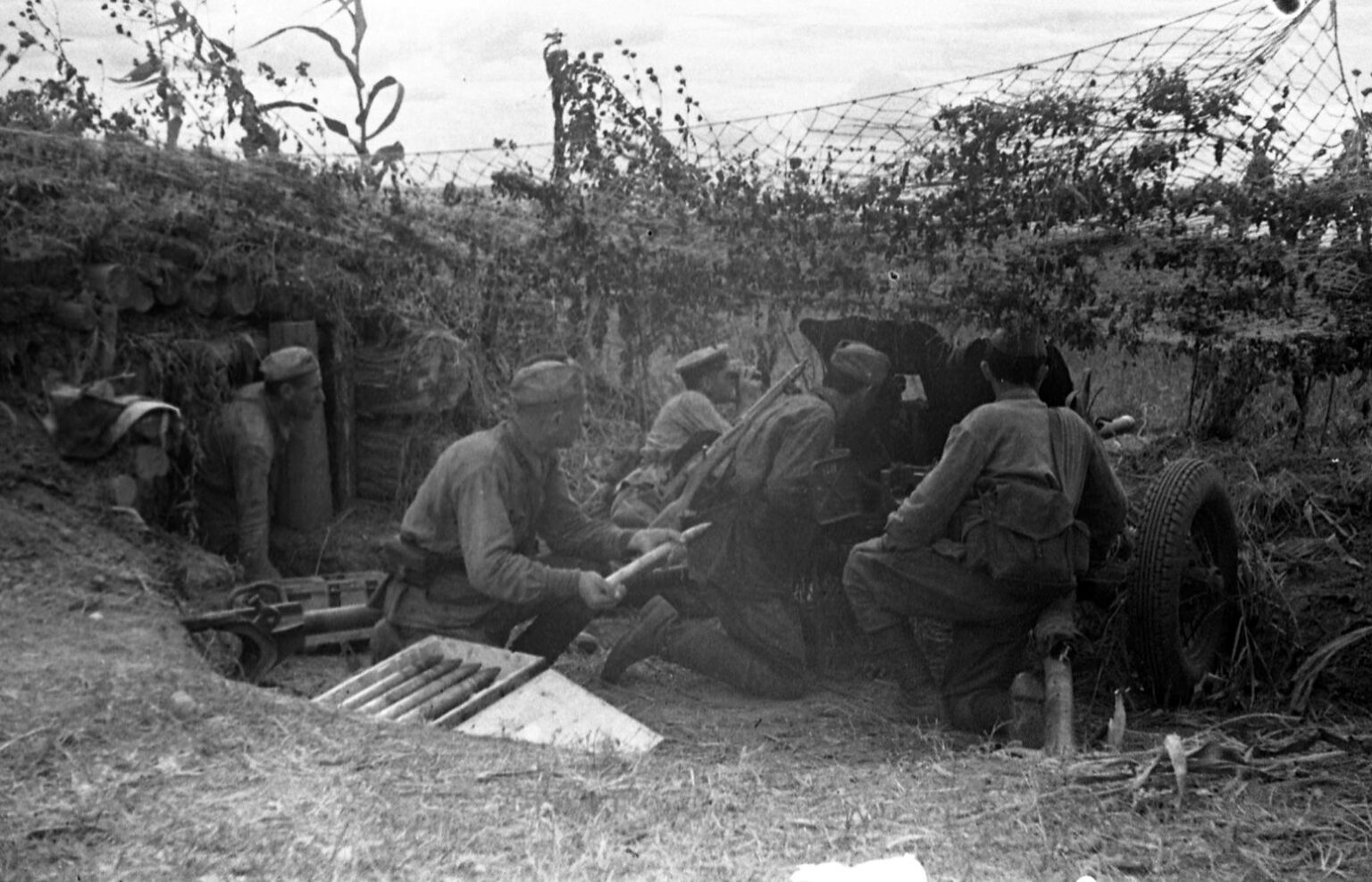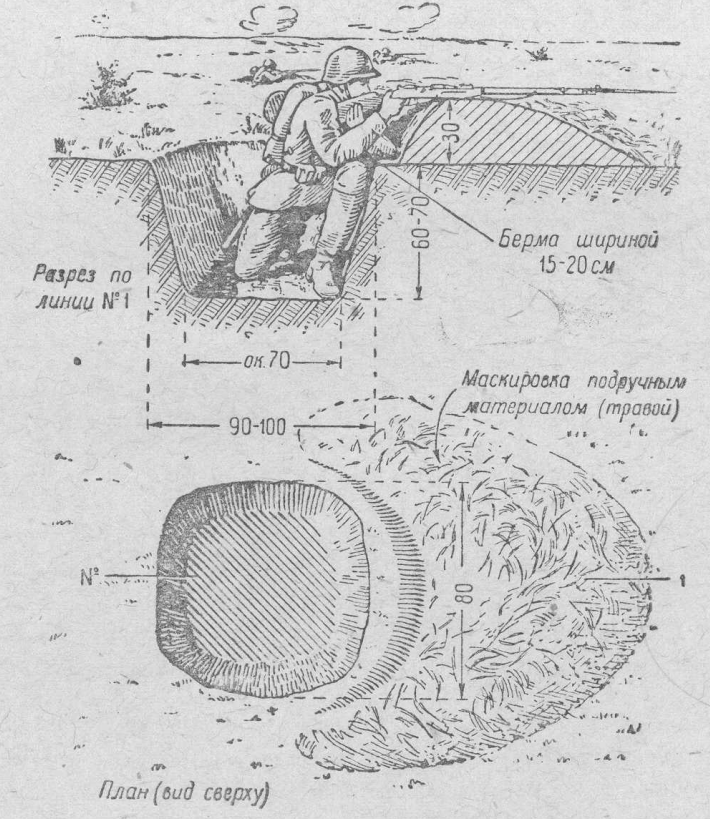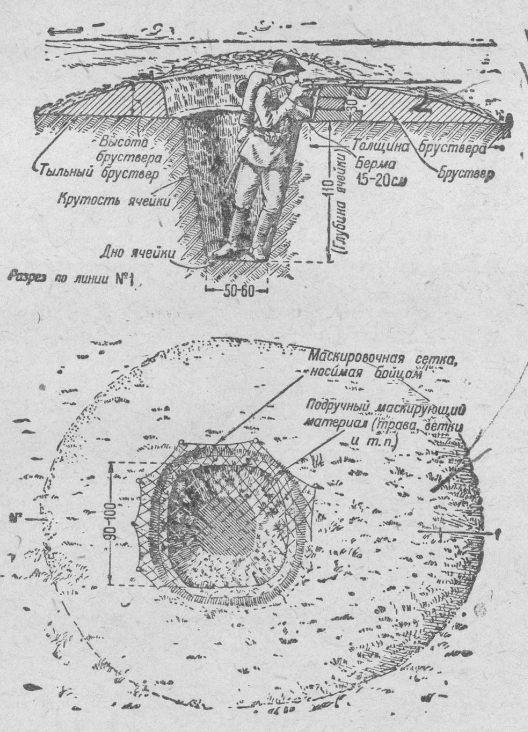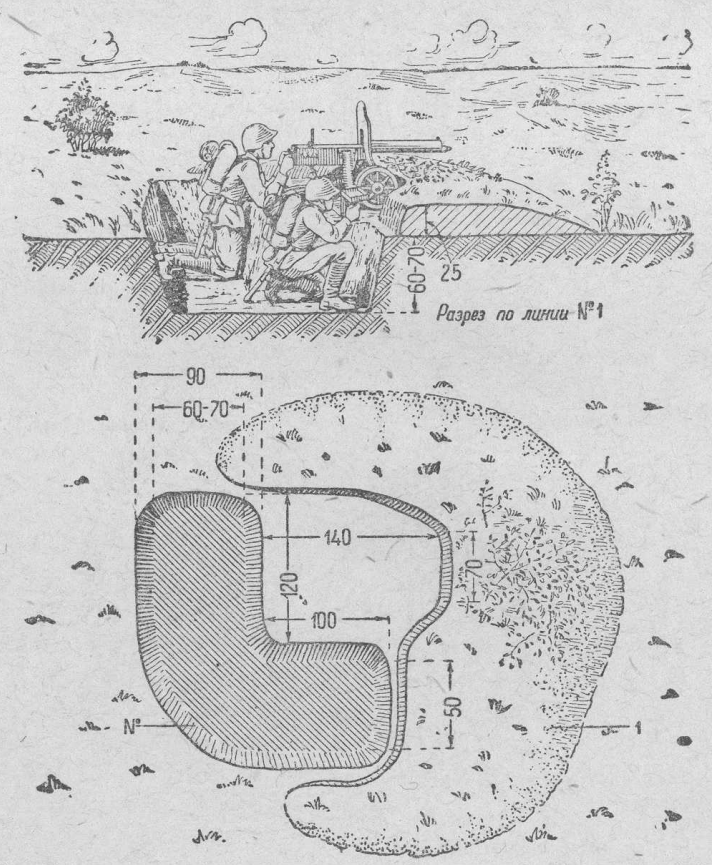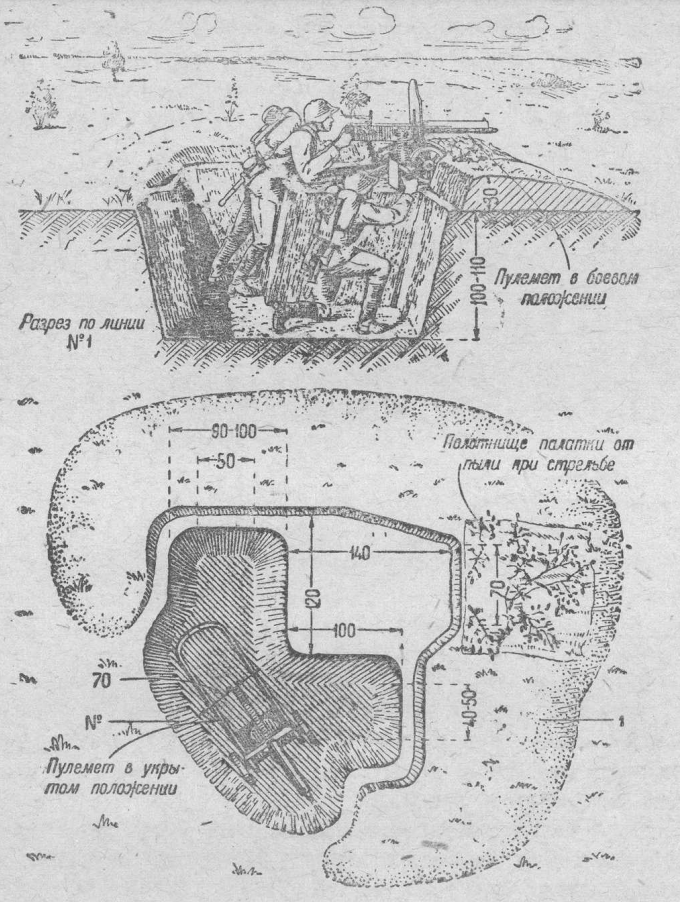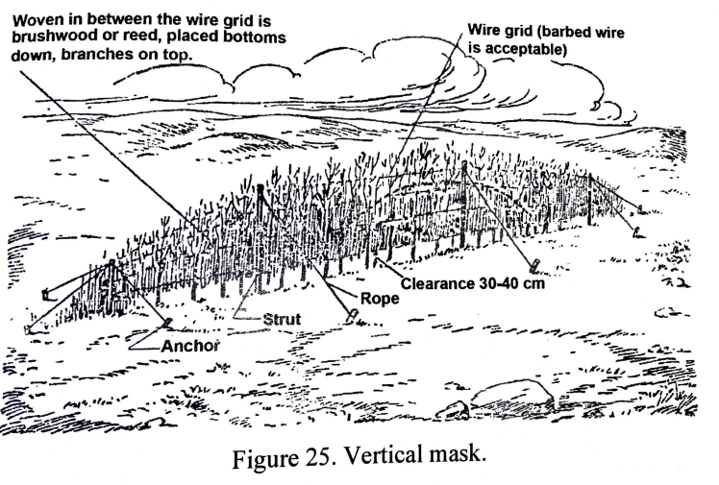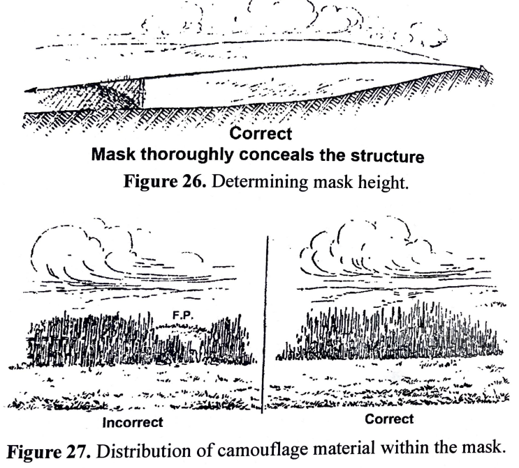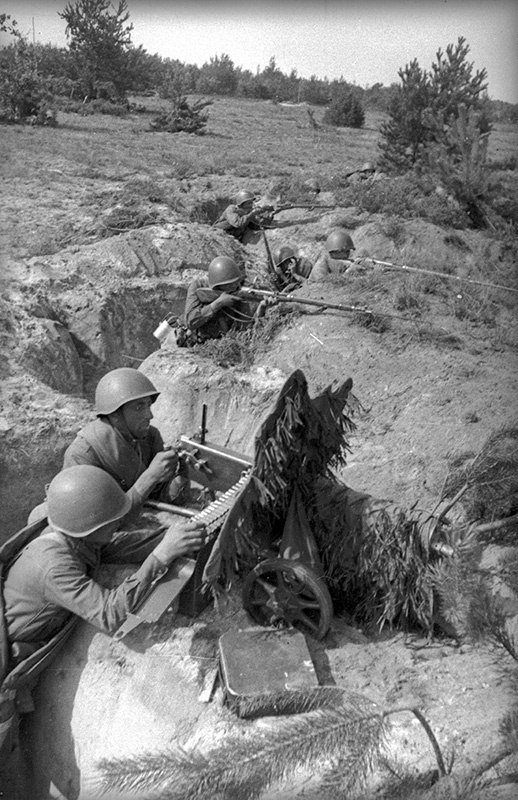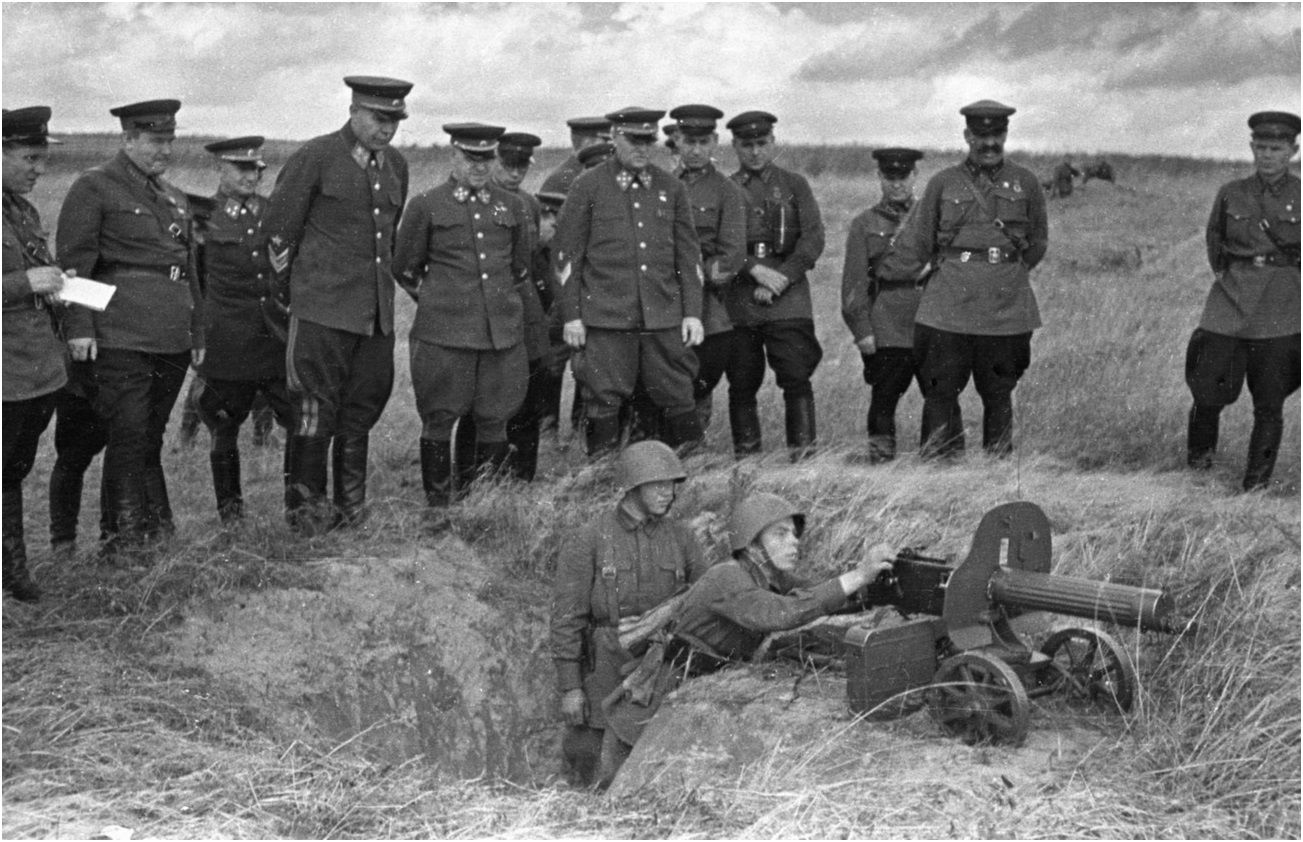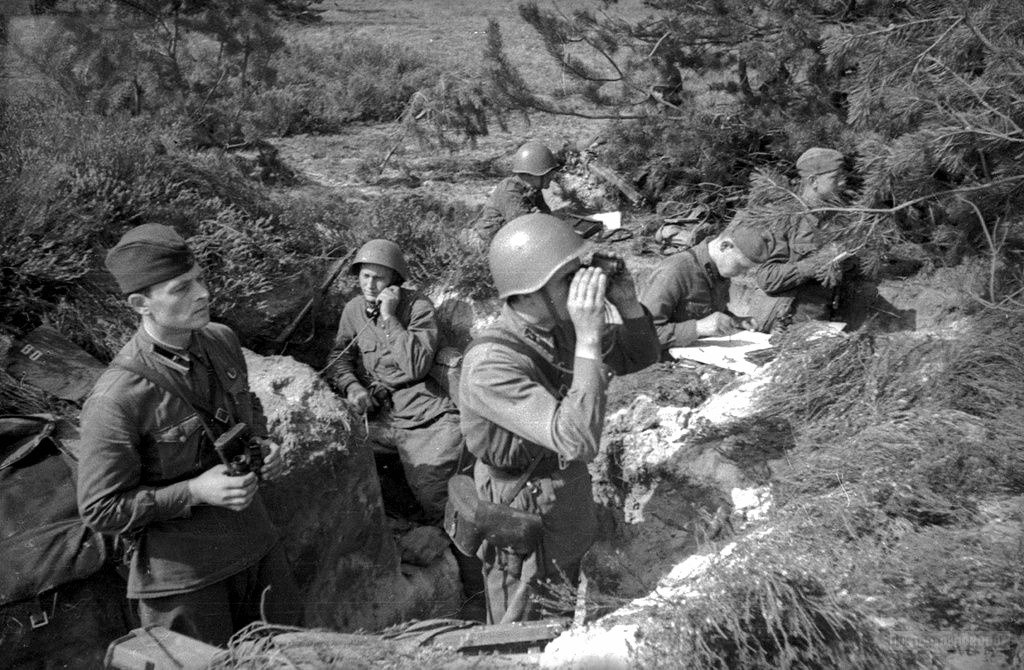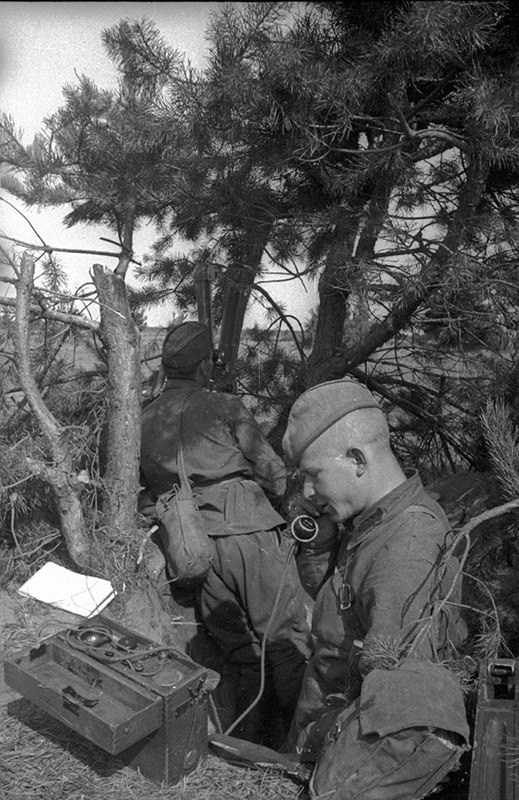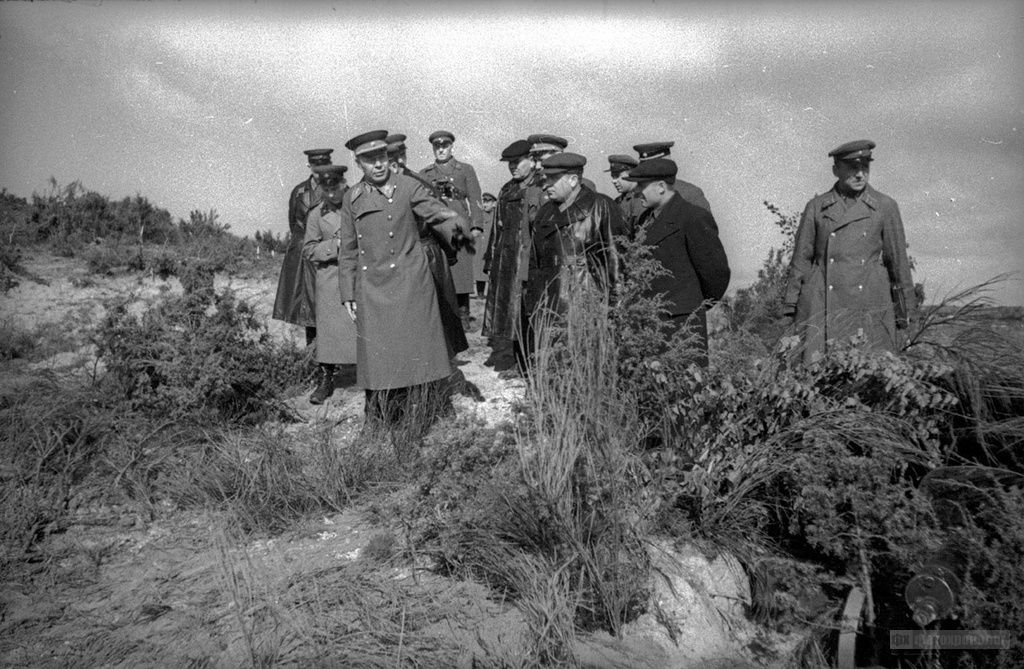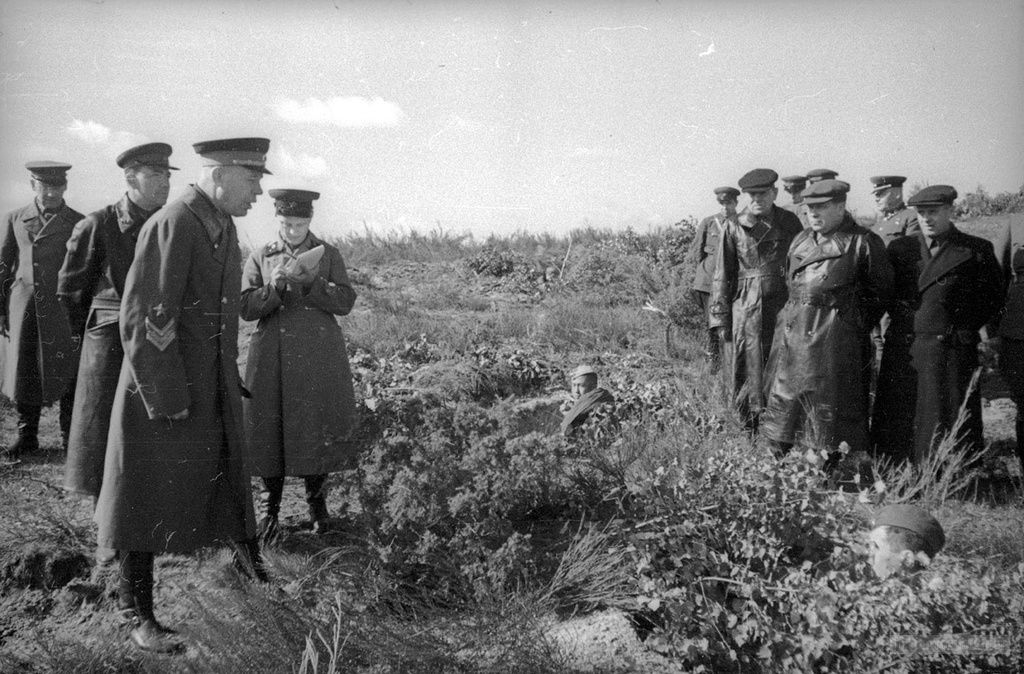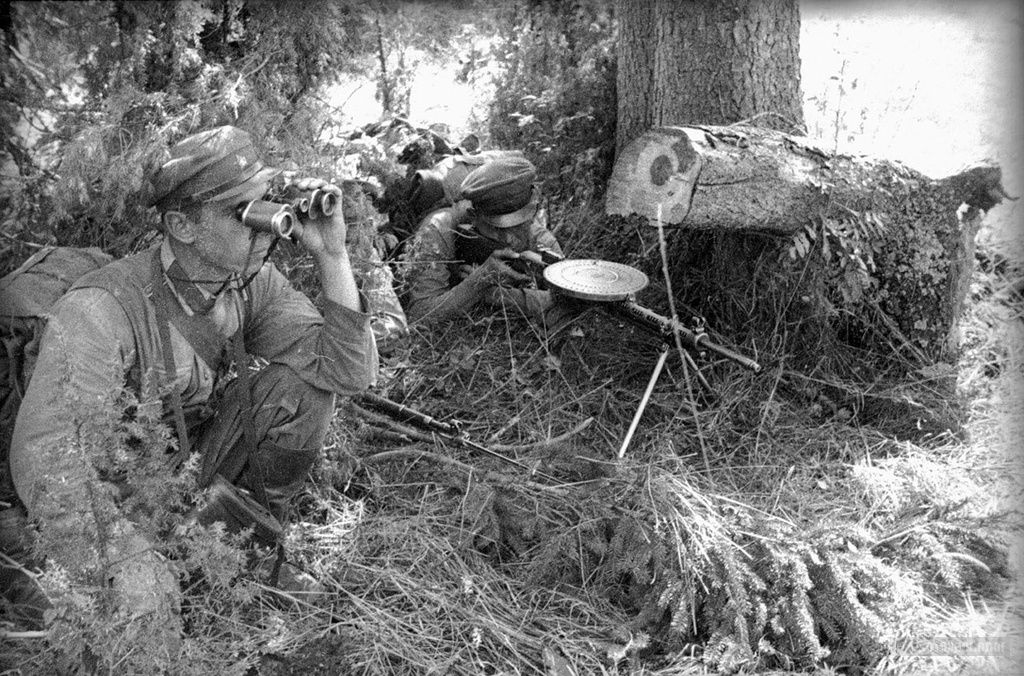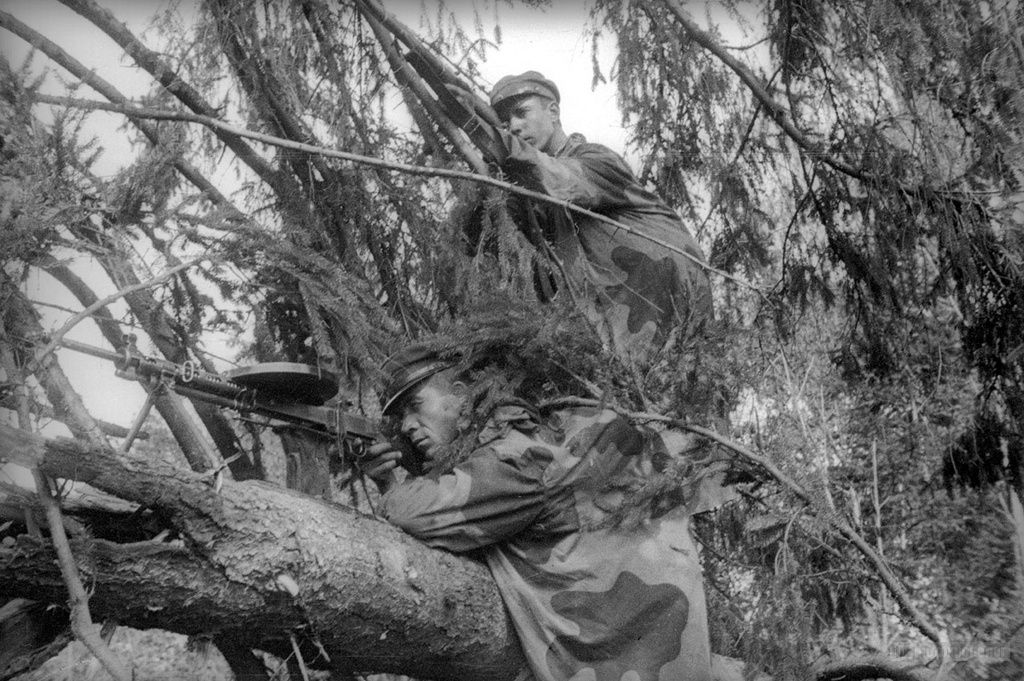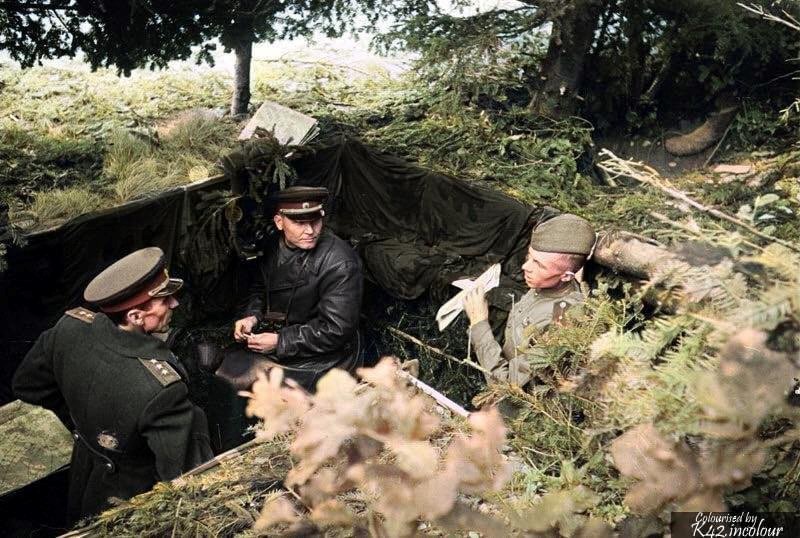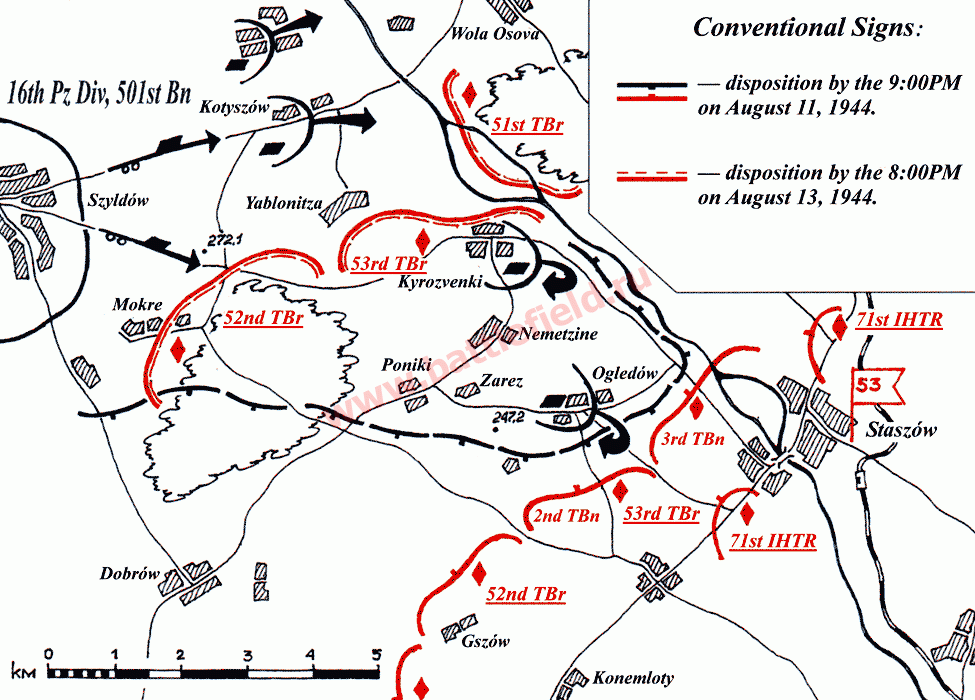Positional Camouflage
By Max Schmidt
This article goes in tandem with a previous article covering the 1939 Trench System document, check it out here. Many of the core concepts of that article we will revisit here, but expanded upon with a focus on camouflage. When thinking of camouflage people usually focus on patterns, uniforms and suits. While this was used in the Red Army, in the form of the amoeba pattern suit worn by snipers and sappers, this will focus on camouflaging your position according to Red Army doctrine and regulation.
First, some basic terms to cover before diving into this subject… Direct observation – the enemy has a direct line of sight on your position. Cover – the enemy can see you but you are protected by fortifications. Concealment – the enemy is unable to see you due to his line of sight being obstructed or by use of camouflage. Oblique fire – fire at approximately 45 degrees to the target. Parapet – a buildup on the edge of a trench slightly protruding above ground level.
Camouflage in a Modern (1940s) Defense
Going back to 1914 and the Frist World War, artillery had dominated the battlefield and lead to massive amounts of casualties. “Everything within the sight of an artillery observer will be destroyed.” Thus, all fortifications must be setup in a way that they will not be seen by enemy artillery observers. “This is the main guideline, and it supersedes all others.”
This principle carried over into the Second World War and the experience of the Red Army proved the above conclusions. Artillery weaponry and observation had significantly improved, thus preparations to camouflaged defensive lines and fortifications was “law” for the modern defense. The Red Army deduced that the modern defense was based on flanking and oblique fire, with supporting fire coming from both the front and rear.
1) Enemy forces are more vulnerable to flanking rather than frontal fire.
2) Flanking fire protects a larger area with less firepower needed than with frontal fire.
3) Flanking structures are engaged less than frontal ones.
Going back to 1914 and the Frist World War, artillery had dominated the battlefield and lead to massive amounts of casualties. “Everything within the sight of an artillery observer will be destroyed.” Thus, all fortifications must be setup in a way that they will not be seen by enemy artillery observers. “This is the main guideline, and it supersedes all others.”
This principle carried over into the Second World War and the experience of the Red Army proved the above conclusions. Artillery weaponry and observation had significantly improved, thus preparations to camouflaged defensive lines and fortifications was “law” for the modern defense. The Red Army deduced that the modern defense was based on flanking and oblique fire, with supporting fire coming from both the front and rear.
1) Enemy forces are more vulnerable to flanking rather than frontal fire.
2) Flanking fire protects a larger area with less firepower needed than with frontal fire.
3) Flanking structures are engaged less than frontal ones.
Indeed, many principles and reasons for using camouflage were similar across various militaries during that time period, including the Red Army. Concealing trench communication lines from enemy ground observation was a common objective. This could be achieved by occupying terrain that provides a dominant position over the enemy and ensuring that a camouflaged parapet hides the occupied position from their view. It is crucial to avoid placing the trench in the line of sight of enemy observers. In situations where the enemy’s position dominates over our occupied position, their view may extend to the rear embankment of our position. In such cases, aerial observation becomes a concern, and it is necessary to fully cover the trenches with camouflage netting to make them less visible from above. Furthermore, modern defense heavily relies on effectively camouflaging automatic weapons and artillery positions. These key defensive elements should be disguised to resemble locally available objects, blending in with the surroundings (see provided examples). By following these camouflage practices, militaries sought to enhance their defensive capabilities and decrease the likelihood of detection and successful enemy targeting.
For areas that are forested, have small bushes or abundant hills and mounds, achieving a camouflaged position is quite easy as the enemy lacks direct observation or it has been obstruction. Here concealment is used to great effect over the standard use of cover. In paragraph 309 of the 1942 Infantry regulations, “In the defense of the forest, the platoon takes up positions in front of the edge or retreated into the depths of the forest. Fire weapons are deployed with the calculation of shooting through the edges, paths, roads, clearings, clearings. Of decisive importance is close-range rifle-machine-gun and mortar fire in combination with natural and artificial obstacles.”
Cover vs Concealment
This photo is a fantastic example of both cover and concealment in use on the defensive by the Red Army. In the top left of the image, there is a reinforced man-made structure that has been covered with natural materials such as brush, grass, and leaves. This demonstrates an effective use of cover and concealment, as the dugout provides protection from enemy fire while being camouflaged to resemble a small hill in the terrain. The soldiers inside the dugout can find cover and shelter while remaining inconspicuous to distant observers.
On the right side of the photo, there is an anti-tank gun that has been concealed using netting and nearby brush. This represents an example of pure concealment, where the focus is on hiding the gunners from distant enemy observers. However, it is important to note that this level of concealment leaves the gun crew vulnerable to enemy fire. Therefore, the reinforced dugout positioned next to the anti-tank gun serves as a means of cover or protection. In the event that the concealment is compromised and the position comes under fire or shelling, the soldiers can seek refuge in the dugout for added protection.
The decision to use only concealment for the anti-tank gun reflects the necessity to maintain the functionality it requires to engage enemy vehicles. Extensive cover could limit the gun’s firing range and hinder its operational effectiveness. By utilizing netting, the gun crew can conceal themselves while still being able to swivel the gun up to 180 degrees, enabling them to engage targets effectively. The netting has also been strategically arranged to extend the silhouette of the dugout, creating the illusion of a natural formation in the terrain and further deceiving enemy observers. This approach provides both protection for the soldiers and effective concealment for the anti-tank gun without compromising its functionality.
This photo is a fantastic example of both cover and concealment in use on the defensive by the Red Army. In the top left of the image, there is a reinforced man-made structure that has been covered with natural materials such as brush, grass, and leaves. This demonstrates an effective use of cover and concealment, as the dugout provides protection from enemy fire while being camouflaged to resemble a small hill in the terrain. The soldiers inside the dugout can find cover and shelter while remaining inconspicuous to distant observers.
On the right side of the photo, there is an anti-tank gun that has been concealed using netting and nearby brush. This represents an example of pure concealment, where the focus is on hiding the gunners from distant enemy observers. However, it is important to note that this level of concealment leaves the gun crew vulnerable to enemy fire if spotted. Therefore, the reinforced dugout positioned next to the anti-tank gun serves as a means of cover or protection. In the event that the concealment is compromised and the position comes under fire or shelling, the soldiers can seek refuge in the dugout for added protection.
The decision to use only concealment for the anti-tank gun reflects the necessity to maintain the functionality it requires to engage enemy vehicles. Extensive cover could limit the gun’s firing range and hinder its operational effectiveness. By utilizing netting, the gun crew can conceal themselves while still being able to swivel the gun up to 180 degrees, enabling them to engage targets effectively. The netting has also been strategically arranged to extend the silhouette of the dugout, creating the illusion of a natural formation in the terrain and further deceiving enemy observers. This approach provides both protection for the soldiers and effective concealment for the anti-tank gun without compromising its functionality.
Preparing a Basic Position
Below will be examples of setting up defensive firing positions incorporating positional camouflage as seen in the 1942 Field Fortifications manual. These are positions for a rifleman, and machinegun team that are made within an hour. If given the opportunity they should be expanded upon and further camouflaged.
Basic Rifleman's Position
The position for shooting from the knee is to be a depth of roughly 60-70cm and 90-100cm wide. The parapet in front of the hole is made to resemble a natural incline in the terrain and covered with nearby materials for camouflage. It is made from the excess dirt dug while making the entrenchment. Between the hole and parapet there is an empty space 15-20cm wide. This space allows for the soldier to rest his elbow when firing his rifle, also it prevents the parapet from falling back into the hole. This position can be setup in 25-30 minutes by a single soldier in average soil.
Advanced Rifleman's Position
The position for shooting while standing is to be 110cm deep and 50-60cm wide for the soldier to stand. The parapet is made to resemble a natural incline in the terrain and covered with nearby materials for camouflage. The space between the parapet and hole is 15-20cm, like before so that the the parapet does not fall back into the hole. This space serves again as a place for the soldier to rest his elbow when firing his weapon, but also as foothold to jump out of his position if needed. The position is covered with a camouflage net fitted with readily available materials, grass, leaves, brush, etc. This position can be setup in 50-60 minutes with a standard issued E-tool.
Basic Machinegun Position
The position for firing the machinegun from the knee is to be 60-70cm deep in an “L” shape allowing space for the assistant gunner to operate. A space about 140x120cm is for the machine gun to rest with the parapet in front covered with readily available materials. The parapet is made from the excess dirt dug while making the entrenchment. This position takes 30 to 40 minutes to setup by a 2 man machinegun team. If given the opportunity the soldiers should deepen their position to allow them to fire from the standing position.
Advanced Machinegun Position
The position for firing the machinegun while standing is to be 100-110cm deep in an “L” shape allowing space for the assistant gunner to operate. The excess dirt dug up to improve the position is used to expand the parapet, wrapping it further around the position. The same 140x120cm space is still reserved for the machinegun with readily available materials camouflaging the parapet. With the hole now depend the soldiers can keep their machinegun hidden and protected if the situation calls for it. With a 2 man team this should take 45 minutes to setup expanding on the basic position.
Veiling of Positions
The task of camouflage in open terrain involves modifying the surroundings to hinder the enemy’s ability to identify specific locations or structures. This technique is particularly useful when natural concealment is limited or unavailable. The optimal approach in open terrain is to employ veiling of positions, which entails erecting masks in front of structures. These masks are vertical, transparent, and made from readily available materials. For example, leafless branches placed in the ground at a distance of 10-15 paces from a structure can render both the structure and the terrain behind it invisible to the enemy, even at distances of 300-400 paces. Observation from behind the mask remains clear, but from the enemy’s perspective, even soldier movements become imperceptible. While the masks themselves may be visible to the enemy, they prevent them from identifying the precise locations of structures or deducing the fire system in place.
Approaches and footpaths leading to the actual structures should not terminate directly at the structures themselves, but instead form a closed circuit that connects all the masks. In some cases, decoy structures can be placed in the gaps between actual structures and behind masks, primarily to confuse aerial observers. It is advantageous to position the structure slightly offset from the center of the mask rather than at its exact center. Varying the distances between the masks hinders the enemy’s ability to accurately adjust their fire on the position or structure. Even if the enemy identifies a mask concealing an actual structure, without knowledge of the precise target location, they cannot effectively target it.
These masks should also be utilized to camouflage communications with the rear, preventing the enemy from observing soldier movements. The design of vertical masks can vary based on the available materials, such as brushwood, reed, or typha. In open fields, masks made from straw are advantageous, as they are barely noticeable against a yellow background. The width of the mask should be 6 to 8 times the width of the structure, generally ranging from 12 to 20 meters for a reinforced concrete cupola. The height of the mask depends on the height of the structure being camouflaged and the locations of enemy observation posts. If our terrain dominates over the enemy, the mask height can be minimal, while it should be much taller if the enemy has the advantage. When arranging the masks, they should taper towards the edges and blend seamlessly into the surrounding terrain. – Camouflaging Field Positions In The Steppes 1942
Camouflage Mistakes to Avoid
The Red Army documented several important considerations as their use of positional camouflage evolved. These factors should be taken into account when applying camouflage techniques to ensure effective concealment. A well-camouflaged position can still be easily identified if there are obvious roads, trenches, or passages leading to it, especially when considering aerial observation or enemy positions overlooking your own (Figure 3). It is crucial to avoid making the camouflaged position appear too artificial or man-made (Figure 13 and 15). Additionally, it is essential to maintain the functionality of the position while camouflaging it, striking the right balance between cover and concealment. When incorporating obstacles, it is critical to ensure they do not unintentionally reveal the presence of your position or fortified structures. Anti-infantry and anti-tank obstacles should be strategically placed behind natural masks, such as in corn fields, hemp, behind fences, tall grass or brush, on reverse slopes, or in terrain folds. Lastly, it is important to remember that camouflage aims to deceive the enemy. If the same pattern is used repeatedly and identically (Figure 2), it becomes easier for the enemy to discern and locate your positions. These are some key principles outlined in Red Army regulations for incorporating camouflage into a defensive position. (Refer to the accompanying photos for visual examples.)
Example Positions
Documented Use
Lt. Aleksandr P. Oskin of the 53rd Guards Fastov Tank Brigade (6th Guards Tank Corps) received orders on the evening of August 11, 1944, to conduct a patrol in the Polish village of Ogledow. The objective was to establish contact with the 2nd Battalion of the unit. Accompanied by a team of tank infantry that had been with him since the battles in Byelorussia and Poland since June, Oskin arrived in the village only to find no friendly tanks present. Meanwhile, German troops were approaching from the opposite end of the town. Oskin reported the situation to the brigade commander, who instructed him to assume a defensive position and monitor the movements of the German troops. To enhance their camouflage, Oskin’s crew and the tank infantry covered the tank hull with corn stalks, blending it into the field. However, this created a noticeable tall section of corn in the area, making it an easy target for the enemy. To mitigate this, Oskin directed his crew and the accompanying infantry to set up “dummy” sections of tall corn stalks, creating the illusion of a natural field and ensuring their camouflaged vehicle did not stand out.
That evening, a German tank column entered Ogledow but halted its advance after dark. On August 12th, orders were given to the King Tiger battalion to take action against the Soviet bridgehead near Sandomierz, situated over the Vistula River. From his position in the tank, Oskin observed the King Tigers departing the village. Leveraging his well-camouflaged tank, Oskin remained unnoticed by the Germans and strategically positioned himself along the road where the King Tigers would expose their vulnerable sides while moving. When the enemy reached a distance of 200 meters, Oskin initiated the engagement, swiftly destroying one of the German tanks. The leading King Tiger, in search of Oskin’s tank, was unable to locate the source of the attack due to the effective concealment of Oskin’s T-34 and the initial chaos of the encounter. After firing four shots, Oskin successfully knocked out the leading Tiger. He then employed smoke canisters from his vehicle to obscure his movements as he maneuvered to confront the third Tiger, which was beginning to retreat. Skillfully circumventing the King Tiger, Oskin targeted and disabled it with a shot into the engine compartment through the thinly armored rear section.
The German forces suffered significant losses during the engagement, with two King Tigers destroyed and one recovered by the Soviets, along with the demise of eleven out of the fifteen crew members. The remaining four crew members were captured by the tank riders supporting Oskin. The Tiger battalion was left perplexed, attributing their losses to what they believed to be “massive anti-tank defenses.” However, the reality was that a lone T-34, facing overwhelming odds in terms of numbers and firepower, had outmatched them thanks to Oskin’s swift thinking and strategic utilization of positional camouflage.
Lt. Aleksandr P. Oskin of the 53rd Guards Fastov Tank Brigade (6th Guards Tank Corps) received orders on the evening of August 11, 1944, to conduct a patrol in the Polish village of Ogledow. The objective was to establish contact with the 2nd Battalion of the unit. Accompanied by a team of tank infantry that had been with him since the battles in Byelorussia and Poland since June, Oskin arrived in the village only to find no friendly tanks present. Meanwhile, German troops were approaching from the opposite end of the town. Oskin reported the situation to the brigade commander, who instructed him to assume a defensive position and monitor the movements of the German troops. To enhance their camouflage, Oskin’s crew and the tank infantry covered the tank hull with corn stalks, blending it into the field. However, this created a noticeable tall section of corn in the area, making it an easy target for the enemy. To mitigate this, Oskin directed his crew and the accompanying infantry to set up “dummy” sections of tall corn stalks, creating the illusion of a natural field and ensuring their camouflaged vehicle did not stand out.
That evening, a German tank column entered Ogledow but halted its advance after dark. On August 12th, orders were given to the King Tiger battalion to take action against the Soviet bridgehead near Sandomierz, situated over the Vistula River. From his position in the tank, Oskin observed the King Tigers departing the village. Leveraging his well-camouflaged tank, Oskin remained unnoticed by the Germans and strategically positioned himself along the road where the King Tigers would expose their vulnerable sides while moving. When the enemy reached a distance of 200 meters, Oskin initiated the engagement, swiftly destroying one of the German tanks. The leading King Tiger, in search of Oskin’s tank, was unable to locate the source of the attack due to the effective concealment of Oskin’s T-34 and the initial chaos of the encounter. After firing four shots, Oskin successfully knocked out the leading Tiger. He then employed smoke canisters from his vehicle to obscure his movements as he maneuvered to confront the third Tiger, which was beginning to retreat. Skillfully circumventing the King Tiger, Oskin targeted and disabled it with a shot into the engine compartment through the thinly armored rear section.
The German forces suffered significant losses during the engagement, with two King Tigers destroyed and one recovered by the Soviets, along with the demise of eleven out of the fifteen crew members. The remaining four crew members were captured by the tank riders supporting Oskin. The Tiger battalion was left perplexed, attributing their losses to what they believed to be “massive anti-tank defenses.” However, the reality was that a lone T-34, facing overwhelming odds in terms of numbers and firepower, had outmatched them thanks to Oskin’s swift thinking and strategic utilization of positional camouflage.
Enemy Perception of Soviet Camouflage
The following contains excerpts from a translation of a German pamphlet on Russian summer camouflage, printed in the spring following the German invasion of Russia in June 1941. The Germans evidently found Russian camouflage methods disconcerting, and some were apparently new to them. The great care the Russians apparently devote to camouflage training is worthy of note; their success in effective concealment seems to have resulted from ingenuity and strict camouflage discipline.
The camouflage instinct is strongly developed in the Russian, and his inventive ability is astounding. This gift is systematically encouraged by thorough camouflage training which begins on the first day of military training and is continued throughout the whole period. Camouflage discipline is good even among troops who otherwise might be well below the average as regards weapon training. Infringements of camouflage discipline are severely punished.
Camouflage Mask for Rifleman
This consists of a wire contraption divided into several pieces, covered with material. In it is a hole through which the rifle can protrude. It represents a bush and is in use in three different colors. It can be folded up and carried on the person in a bag. The rifleman lies in such a position behind the mask that his body is fully hidden. In attacking he can move forward in a crouch and push the mask in front of him. The mask is only visible to the naked eye at a distance of 150 to 200 paces.
Camouflage Fringe
The fringe consists of a band about 3 yards long, from which grass colored matting is hung. On the ends are hooks for attaching the fringe on the object. The rifleman can fix the fringe on the helmet or shoulders. Five of these fringes are used to camouflage a machine gun, and six for an antitank gun.
Camouflage Fringe
The fringe consists of a band about 3 yards long, from which grass colored matting is hung. On the ends are hooks for attaching the fringe on the object. The rifleman can fix the fringe on the helmet or shoulders. Five of these fringes are used to camouflage a machine gun, and six for an antitank gun.
Observation and Sniper Posts
A tree stump is hollowed out and stakes are used as supports. Another method is to insert periscopes into a frame made to look like wooden crosses in cemeteries (see figure 2). Imitation hayricks are often used.
Camouflage Against Observation from the Air
Shadows can be cast by fixing frameworks on the side of a house or on the roof so that the object cannot be recognized. Branches fixed on wire strung over the object can make it invisible from the air.
Camouflaging Tanks and Tank Tracks
Tanks when being transported by rail or when on the road can be made to look like roofed freight cars or ordinary trucks. When there are groups of trees, camouflage can be quickly obtained by bending the tops of the branches over the objects to be camouflaged (see figure 4). Nets can also be spread over and attached to the trees, with natural material laid on top. Among low bushes, tanks can be covered with grass, moss, or twigs. Freshly cut trees, one-and-a-half times the height of the object to be camouflaged, complete the camouflage. Tanks on a slope can be effectively and quickly camouflaged by the use of netting or other covers. Tanks in hollows can be made invisible by covers and, even without natural camouflage, nets or covers can completely alter the shape of tanks. Tank tracks can be obliterated by dragging a fir tree behind the tank; rolls of barbed wire with an iron rod through them can also be used for this purpose.
Quarters and Bivouacs
All evidence of the occupation of a village is avoided. Tanks, guns, and vehicles, if they cannot be brought under cover, are placed in irregular formations and camouflaged in yards and gardens, and against hedges, bushes, walls, and trees. Special care is taken to see that movement from one place to another is limited to small groups; this rule applies also when issuing food, gasoline, etc. Destroyed villages and burned-down premises are preferred for quartering men, weapons, equipment, and vehicles, as these areas lend themselves easily to camouflage. Bivouacs are cleverly camouflaged against houses, hedges, gardens, etc. If possible, thick woods are used, and use is made of branches. In open country, hollows and ditches are used to the utmost, and bivouacs spread out in irregular formations. Tents are covered with natural camouflage material; if this is lacking, no use is made of tents. Instead, holes and pits are constructed. When bivouacs are taken up, tracks are obliterated in order to give the enemy no indication as to strength.
Battle
Stress is laid on the necessity of being able to crawl for long distances at a quick pace. Patrols are well equipped with camouflage suits, and make full use of darkness and bad visibility. When working forward, the Russian moves in short, quick bounds, and is capable of moving through the thickest undergrowth in order to work his way close to the enemy position. If the defense is on the alert, he is able to lie still for hours on end. Russian tree snipers are particularly difficult to recognize. Tank-destroying sections with Molotov cocktails, grenades, and mines, are distributed in wheat fields and at places several yards from the edges of woods and fields.
In defending built-up areas, the Russians make use of positions outside the area. These consist of many rifle pits, organized in depth and well camouflaged with fences and bushes. When firing from houses, machine guns are placed well back from windows and doorways to prevent the flash being seen, and also to smother the report. When German aircraft appear, every movement ceases. After firing, any discoloration in front of a gun is covered with suitable camouflage material. When the gun remains for some time in one position, a board of sufficient size, and colored to match the surroundings, can be laid in front of the muzzle. As the presence of tanks leads to definite conclusions regarding the main effort of the attack, the Russians are very careful to camouflage their armor.
Layout of Defense Positions
Reconnaissance patrols are instructed not only to study the ground from the tactical point of view but also as regards possibilities for camouflage. This includes shape of the ground formations, the background, the coloring, the available natural camouflage, and what suitable artificial camouflage material can be used. Positions are selected to conform to the natural contours of the ground, and comfort is of secondary importance. As much use as possible is made of reverse slope positions. Parapets are kept as low as possible and are carefully camouflaged with grass, etc. Positions are often camouflaged with covers made of boards, fir branches, or straw. If time does not allow, only single portions of the trench system will be covered, so that to an observer they look like connecting trenches. Provision is made to conceal vision slits. Antitank ditches are either entirely covered, or partially covered in such a way that they look like narrow, easily passable ditches (see figure 5). Pillboxes are carefully camouflaged with nets or covers. The open walls are painted with a mixture of tar and asphalt, and covered with earth or hay. Wire obstacles can be made invisible by passing them through hedges and fences.
In woods, thick undergrowth is preferred in selecting a position. Cutting down trees to give fields of fire is avoided for reasons of camouflage. Russian signalmen use telegraph poles, with the bark still on, and set them up at irregular distances. The line of poles is laid to conform with the country. Earth at the foot of the poles is carefully camouflaged, and trampling of the earth along the line of the poles is strictly avoided. Wire is also laid to conform with the general contouring. Camouflage discipline in occupied positions is very good, and one seldom hears talking, rattling of weapons, or sees the glimmer of a cigarette. In order to prevent the enemy realizing that a position is weakly held, single riflemen keep up strong fire activity at various points.
Dummy Positions
The Russians often use dummy positions. Dummy trenches are of normal width, but are dug only to a depth of about 1 1/2 feet. The bottom can be made dark with soot or pine needles. Dummy dugouts can be made by the use of props, with the entrance made of cardboard or paper. Dummy loopholes and observation slits can be made out of black paper or felt. Dummy gun positions can be arranged by turning over grass, or burning it in order to imitate discoloration from muzzle blast. Dummy gun positions must be at correct distances. The representation of dummy tracks leading to the dummy positions must not be forgotten. The desired result is achieved by mowing grass to the normal width of a track, and letting the mown grass remain, or rolling it. When the ground is open, color must be used in order to make the tracks light and trenches dark.
Dummy obstacles can be erected by mowing grass and making little heaps out of the cut grass. On a ploughed field, it is sufficient to plough at right angles to the furrows to the width of the particular obstacle it is desired to represent. Dummy mine pits can be made by taking out sods of turf and laying them down clumsily. The dummy minefields should be two to four times as obvious as the normal. In dummy minefields 5 to 10 percent of live mines are generally laid. Dummy light installations are used a great deal in order to portray a station, industrial plant, or airfield. Lanterns, dummy bivouacs, and camp fires are often arranged to give the impression of the presence of troops.
Sources:
Gerbanovsky, S. E. Infantry Fortification . 1st ed., vol. 1, People’s Commissariat of Defense, 1942.
Shperk, V. F. Camouflaging Field Positions In The Steppes. 1st ed., vol. 1, People’s Commissariat of Defense, 1942.
BATTLE REGULATION. INFANTRY OF THE RED ARMY. 1st ed., vol. 1, People’s Commissariat of Defense, 1942.
Voroshilov, K. BATTLE CHARTER OF THE INFANTRY OF THE RKKA. 1st ed., vol. 1, People’s Commissariat of Defense, 1939.
Engineering troops of the Soviet Army 1918-1945. – M.: Military Publishing, 1985.
Škadov, I. N. Geroi Sovetskogo Sojuza: Kratkij Biografičeskij Slovarʹ. Voennoe Izdatelʹstvo, 1987.
U.S. Military Intelligence Service. “German Views on Russian Summer Camouflage.” Tactical and Technical Trends, vol. 1, no. 23, 22 Apr. 1943. 1.

